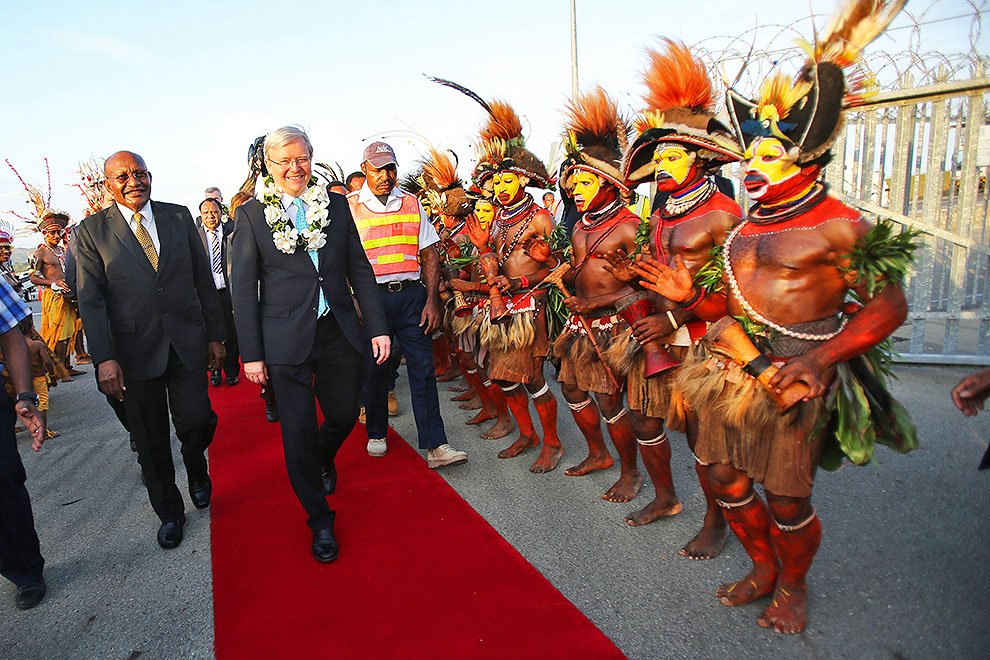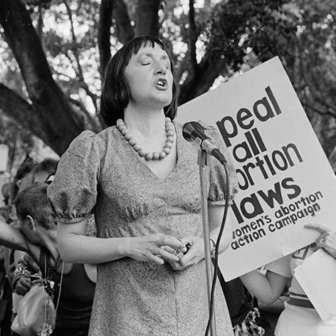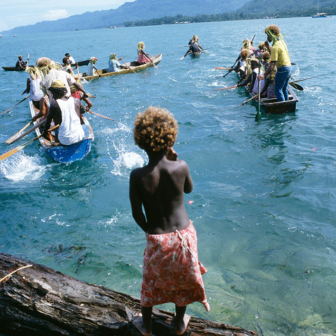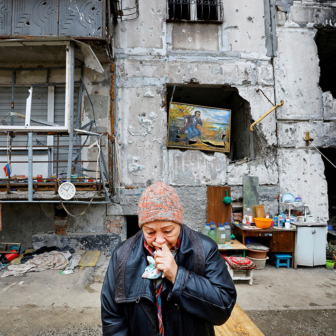A small leap across the Torres Strait from Queensland’s Cape York, just 3.7 kilometres from Australian soil at its nearest point, is Papua New Guinea, home to one of two sites used as an Australian “regional processing centres” since 2012. Around 1500 people have been sent here over the last few years, to be held in a closed detention facility while they await the processing of their asylum claims. Every one of them originally sought asylum in Australia. Every one of them was detained and screened in Australia before being transferred to Papua New Guinea against their will.
For three-and-a-half years, Papua New Guinea has been a central pillar of Australian immigration policy. Under a series of agreements, the Pacific nation not only consented to Australia’s building and operating an immigration detention centre in its territory, but also offered the possibility of permanent settlement in Papua New Guinea to those men found to be refugees and willing to stay.
Until recently, this second offer distinguished Papua New Guinea as arguably the most crucial component of Australia’s offshore asylum architecture. With the apparent collapse of the Cambodia deal, the Australian government’s rejection of New Zealand’s resettlement offers, and no other country putting its hand up to take the 2000 people waiting offshore for a solution, Papua New Guinea was the only viable settlement country (other than Australia) for the foreseeable future.
Late last month the Supreme Court of Papua New Guinea threw this arrangement into disarray. In a unanimous ruling, the panel of five judges held that the detention of asylum seekers and refugees in the Australian-built centre was unconstitutional and illegal. The Supreme Court ordered both the Australian and PNG governments “forthwith” to take all necessary steps to cease and prevent this unlawful detention, and the continued breach of the detained men’s constitutional and human rights. The judgement left no ambiguity: detention in Papua New Guinea must end immediately.
Within twenty-four hours PNG prime minister Peter O’Neill issued a press statement declaring that the centre his country had hosted since 2012 would close. Noting that he welcomed the court’s judgement and had never anticipated asylum seekers being detained for so long, O’Neill announced that he would “immediately ask the Australian government to make alternative arrangements” for the men still there.
What these arrangements may be remains to be seen. Anyone found to be a refugee may still be invited to live in Papua New Guinea if they want to, but the others will have to go elsewhere. Meanwhile, the two countries could find themselves liable for more than $1 billion in compensation claims from the people they illegally detained – some for as long as almost three years.
So what were the arrangements for offshore processing in Papua New Guinea, and how did it all go so wrong?
Stretching out into the blue of the Bismarck Sea, almost reaching the equator, lies the string of islands known as Manus Province. The smallest and least-populated of Papua New Guinea’s twenty-two provinces, some 800 kilometres due north of Port Moresby, Manus is mostly jungle and tropical rainforest. The area is known as one of the most peaceful and beautiful parts of the country. Remote, with temperatures into the forties and 100 per cent humidity some days, it is visually gorgeous.
Manus Island, the largest in the province, is commonly referred to as the location of Australia’s regional processing centre in Papua New Guinea, the Manus RPC. In fact, the centre sits on the same site as it did during the years of John Howard’s Pacific Solution: inside the Lombrum naval base on Los Negros Island, immediately adjoining Manus Island but separated by a narrow stretch of water.
Australian Defence Force engineers were sent in to reclaim the site from the jungle, and assess the remnants of the Howard-era detention centre, within days of prime minister Julia Gillard’s August 2012 announcement that Australia would resume offshore processing. The site as they found it was uninhabitable – overgrown, dilapidated and ridden with termites. Video footage of an early walk-through showed broken flyscreens, splintered wood, exposed wires and broken machinery. This was where families and children as young as seven would sleep. Single men would be housed in tents, erected wherever space could be found.
The arrangements for operating the Manus RPC were governed by a memorandum of understanding between Papua New Guinea and Australia, using similar terms to a sister agreement for processing on Nauru. Australia would transfer, and Papua New Guinea would accept, an unspecified number of people who had reached Australia by boat and sought asylum. Papua New Guinea would “host” these asylum seekers in an “assessment centre” while their claims were processed, and then they were all expected to leave Papua New Guinea as soon as “reasonably necessary.” The Australian government would pay for everything.
These were the days of the Gillard government’s elusive “no advantage” policy. The plan seemed to be that everyone who was a refugee would resettle in Australia one day, but when that might occur was anyone’s guess. Figuring out a timeframe, and indeed an endgame, would be problems for the future. The Gillard government’s immediate priority was getting the offshore centres open and operational as quickly as possible. Those in charge wanted to send as firm and fast a deterrent message as possible to those who might be in Southeast Asia contemplating a boat journey to Australia: do not come here; we will not accept you.
Before it even began, problems with local land and business owners threatened to derail the Manus project. The Australian immigration department had wasted no time lining up a series of Australian companies to operate and provide services at the Manus RPC, and by October 2012 there were rumours that the first asylum seekers could be arriving any day.
The Manusians, meanwhile, had never been given a chance to tender for the lucrative contracts Australia was awarding, and had been shut out of discussions about how their land would be used. Their early protests and threats to boycott the project would eventually be subdued, most notably by the arrival of PNG paramilitary riot squads, notorious for their brutality in the face of dissent. But underlying tensions lingered.
The first planeload of asylum seekers bound for Manus – seven families, including four children – took off from Australia shortly before midnight on 20 November 2012. They arrived early the next morning, accompanied by Australian Federal Police officers and with the full PNG riot squad at the ready on the ground. The show of force was not for the families’ sake. “They were frightened, bewildered, confused, sad people,” recalled John Vallentine, an Australian doctor deployed to the RPC at the time. “A number of them said to me, ‘What is this place? Where are we? Where have we come to?’ They hadn’t been told.”
These families, and those who followed them, would remain on the island until July 2013, when they were shuttled back to Australia without having been processed. They had been sent to Papua New Guinea before any systems were in place for refugee status determination, to a detention centre far from ready to accommodate them. Their transfer had been a message, a warning of sorts. Even women and children would be sent offshore. There would be no exceptions.
The transfer of single men and families to the Manus RPC was controversial from the outset. After a mission to the centre in January 2013, the UN refugee agency, UNHCR, reported that asylum seekers were being arbitrarily detained in violation of international law, and in harsh conditions likely to damage their physical and psychological health. The situation of the youngest detainees was particularly concerning. UNHCR called for the detention of children on Manus to be terminated as a matter of priority.
Prime minister O’Neill had said from the very beginning that he didn’t want asylum seekers to be detained out on Manus “too long.” With speculation that Australia’s no-advantage policy could see refugees languishing in detention for as long as five years, Manus MP Ronny Knight likened such a term to a jail sentence. “Anybody would go stir-crazy for five years there,” he warned, “and I think that’s wrong.”
Belden Norman Namah, Papua New Guinea’s opposition leader at the time, also took issue with the arrangement. In January 2013 he announced that he was heading to court to “challenge the right of the government to force people seeking refugee status in Australia to enter Papua New Guinea to be illegally and indefinitely detained under inhumane conditions.” He sought an injunction preventing the transfer of any further asylum seekers from Australia until the case could be decided. Justice David Cannings of the PNG National Court, while “impressed” by Namah’s arguments, decided against making this order. The arrangement with Australia remained on foot.
From its hopeful origins, the Namah case quickly became bogged down in the PNG court system, progressing haltingly as the parties fought over procedural matters. Meanwhile, in the absence of any court order to the contrary, asylum seekers continued to arrive from Australia and be detained at the RPC, in circumstances that would not be recognised as unconstitutional and illegal until years later.
On 19 July 2013, just seven weeks before the federal election, newly reinstated prime minister Kevin Rudd appeared at a press conference in Brisbane, with prime minister O’Neill by his side, and made a stunning announcement. From that day onwards, no asylum seeker who arrived by boat would be given the chance to settle in Australia. Instead, offshore processing would continue, and anyone found to be a refugee would have only two options: settle in Papua New Guinea (or some other country that would take them), or go home.
For the first time in Australian history, the country was closed off completely to refugees arriving spontaneously at the border by sea. Responsibility for processing and settling these refugees shifted entirely to other countries in the region. There would be no exceptions, not even for children or refugees with immediate family members already living in Australia.
Rudd’s new policy was initially recorded in a “regional resettlement arrangement” with Papua New Guinea, then formalised over the coming weeks in new bilateral agreements with that country and Nauru. The new deals kept much of the existing arrangements in place – apart from the issue of what would happen to refugees after they had been processed. They appeared to suggest that all refugees processed in Papua New Guinea would be permitted to settle and remain there forever. Reality would unfold very differently.
In the weeks and months following Rudd’s announcement, the Manus RPC, like the facility on Nauru, would gradually be emptied as the asylum seekers who had been held there since the previous year were taken back to Australia, unprocessed. The move was intended to make space for the new cohort of asylum seekers – all adult men this time on Manus, all subject to the new rule of no resettlement in Australia.
But space was in short supply. By the time the federal election rolled around in September 2013, the population of the Manus RPC had ramped up from 130 to 723 men – an increase of almost 600 per cent in seven weeks. By the end of the year, under Tony Abbott’s new government, the number of men held on Manus had grown again to 1200.
As the centre heaved under the pressure of the new arrivals, its outer limits remained fixed. The space grew increasingly cramped, and living conditions rapidly deteriorated. The men’s health and safety – already under threat – inevitably suffered.
Life in detention on Manus had always been difficult, but by late 2013 it reached extreme levels. Most men were still housed in converted shipping containers and old tin buildings, sleeping on tightly packed double bunks. “P Dorm” was among the worst: a forty-metre-long building with a curved corrugated iron roof where more than one hundred men were forced to live. In some parts the bunks were so close that a grown man would need to shuffle side-on to get through. The heat was unbearable, as was the stench of so many men crammed into tight quarters, in a tropical climate, with no ventilation. Sometimes the residents of P Dorm found snakes inside, and the building flooded in the rain. One guard and former firefighter described it as a “death trap” and “a hazard to everyone who lived there.”
Elsewhere in the RPC, heavy rains would wash rubbish into the areas around men’s living quarters, causing a putrid stench as it rotted in the heat and humidity. Fresh food was a rarity, and the meals men did get kept the sick bays in frequent use with regular outbreaks of gastroenteritis. There were acute shortages of clothing, underwear and basic hygiene products. Few men had proper shoes, and it was nearly impossible to keep clean – the toilets were eternally filthy, and one compound had just a single washing machine for the 400 men detained there.
No matter how bad the conditions got, though, they were never the primary concern of the men detained on Manus. Above all else these men wanted just two things: to be processed, and to know what plans were in place for their future. Neither was forthcoming.
By early 2014 the Manus RPC was on the verge of a meltdown. Many of the staff did their best within a broken system – trying to manage the situation, repeatedly raising concerns with the Australian government about the inadequacy of existing infrastructure and security. Yet men continued to arrive, faster than capacity could grow to accommodate them. Service providers pleaded with the Australian government to engage with the men’s concerns about their future, and provide some clear answers. Their pleas went unanswered. No one was processed. No one knew what would happen next.
As anger, frustration and anxiety grew, hostility and misunderstandings between the detained men and the local population added fuel to the fire. The two groups had never been properly introduced to each other. Most Manusians knew nothing about the men hidden away behind the high fences of the RPC. On the other side, among the men, understanding of the country in which they found themselves was a mixture of fact and fearful conjecture. To keep them in line, some of the expatriate guards whipped up terrifying stories of Papua New Guinea as a country of barbaric, cannibalistic tribes who practised witchcraft and vigilante justice. As the men’s fears for their future deepened, so too did the antagonism between them and the people outside the fence.
In February 2014, this perfect storm erupted into a violent and deadly riot that rocked the RPC, leaving one young man dead and scores more seriously injured. One man had his throat slit open from ear to ear, another was shot, and many more were beaten. This riot would prove to be a turning point in the RPC’s history. From this point forward, the majority of men detained in Manus would never again trust the country that had hosted them, and where they were later expected to make a home.
Alongside various other inquiries in the wake of the Manus riot, Justice Cannings decided to launch his own judicial probe into the treatment of the men held inside the RPC. Using his constitutional power to investigate whether they were freely enjoying their rights in detention, he began gathering evidence about the inner workings of the facility. He didn’t get far. The inquiry was shut down almost immediately, with PNG foreign affairs and immigration minister Rimbink Pato citing judicial “bias.” Pato described the move to block the investigation as a “joint effort” between Papua New Guinea and Australia. Justice Cannings launched a second inquiry as soon as the first was suspended. This too was shut down.
The judge may have been stonewalled, but the Namah case continued – slowly. Just a few weeks before the riot in February 2014, the PNG Supreme Court had confirmed that Namah had standing to challenge the constitutionality of the arrangements between the Australian and PNG governments regarding the transfer of people who had sought asylum in Australia. But it would still be more than two years before a judgement was reached reached. A few dozen men were released into the PNG community during this time, but most remained in detention. These would be bleak years.
Men began to “disappear” into a secret compound, re-emerging days later with incredible stories of having been locked up, beaten, threatened and tortured. Chauka, known formally as the “managed accommodation area,” did not appear on any of the official maps. Described as a specialised isolation unit for men who “misbehaved,” it consisted of three converted shipping containers arranged in a triangle with only one route in or out; it was away from the other accommodation areas, guarded at all times, and the containers had no windows or ventilation – just a single bed in each.
By the end of 2014, records would show that teenage boys and men were being sent to the shipping containers and held there at an average rate of three per week. The Australian immigration department denied that there was anything exceptional about the area in question. There would never be an independent inquiry into the allegations of what went on there.
Elsewhere around the Manus RPC, minor ailments escalated into serious health conditions. In the remote, hot tropics, with cramped and unhygienic living conditions, infections were quick to develop and potentially fatal. Adequate healthcare simply was not available on site, and recommendations for medical evacuation were staunchly resisted by the Australian immigration department, who had the final say on all health matters. The tragic case of Hamid Khazaei, dead at the age of twenty-four after an infected cut was left untreated and urgent calls for medical evacuation were ignored, did little to change procedure.
Men were shattered psychologically. One, thirty-one-year-old Mohammad Albederee, began a hunger strike so long, and so devastating in its impact on his body, that it morphed from a voluntary protest into a critical health condition. Sources close to Albederee said he had tried to cut open his stomach to prove it was empty. Later he reportedly had a fit and bashed his head against a wall until he lost consciousness.
Mental health staff at the RPC said people were “off the ledge and in a downwards spiral,” with a large number requiring strong psychiatric medication on a daily basis. Men had nothing to do to the pass time: no work, no school, no skills training, no cultural sensitisation. Depression, anxiety, self-harm and suicide attempts were rampant.
As the first anniversary of the February riot approached in early 2015, there was a brief and intense flare of protest within the centre, but it was quickly quashed. By the second anniversary, most men in the Manus RPC had been detained there for several years. They barely stirred. They were broken.
Almost three-and-a-half years after Namah first filed his case challenging the detention of asylum seekers at the Manus RPC, the verdict finally came in. The detention of asylum seekers on Manus had been illegal all this time, and Australia and Papua New Guinea together were ordered to make things right.
Perhaps the men inside the centre were euphoric when the first whispers of the judgement reached them. Perhaps they were fearful of being sent somewhere even worse. It is hard to know, because there they have stayed, locked away behind the gates of their remote detention centre.
Detention has not ceased forthwith on Manus. Public and media access has continued to be restricted, and there has been no word on when this illegal detention might end. Most importantly, there is no word on what might be in store for them next. The broken men of Manus, like other men, women and children in Nauru and Australia, are still stuck – waiting, perpetually, for a safe place to call home. •
This article is based on ’s new book, Offshore: Behind the Wire on Manus and Nauru, available now from NewSouth Books.




